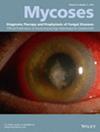Diagnostic Accuracy of Dermatoscopy Versus Microbiological Culture and Polymerase Chain Reaction in the Diagnosis of Onychomycosis: A Cross‐Sectional Study
IF 4.1
2区 医学
Q1 DERMATOLOGY
引用次数: 0
Abstract
BackgroundSeveral clinical signs in dermatoscopy are very characteristic of onychomycosis and can be a quick complement for the diagnosis of onychomycosis.ObjectivesThe aim of this study was to evaluate the diagnostic accuracy of dermatoscopy compared to microbiological culture and polymerase chain reaction (PCR), as well as the clinical signs associated with onychomycosis.MethodsThe clinical signs of 125 patients were assessed cross‐sectionally using dermatoscopy, and a positive or negative result was assigned. A sample was then taken for PCR and microbiological culture.ResultsOf the 125 patients, 69.6% (87/125) had positive results when both laboratory tests were combined. When they were not combined, the prevalence was lower at 48% (60/125) with PCR and at 43.2% (54/125) with culture. Furthermore, 76.8% (96/125) were classified as positive with dermatoscopy with a sensitivity of 1, a specificity of 0.76, positive predictive value of 0.91 and negative predictive value of 1 (with 95% confidence intervals). Of the 96 dermatoscopy‐positive samples, 36 were negative with PCR (皮肤镜与微生物培养和聚合酶链反应在诊断甲癣中的准确性:横断面研究
背景皮肤镜检查中的一些临床表现是甲癣的特征性表现,可以作为诊断甲癣的快速补充。研究目的评估皮肤镜检查与微生物培养和聚合酶链反应(PCR)相比的诊断准确性,以及与甲癣相关的临床表现。结果 在 125 名患者中,将两种实验室检测合并后,69.6%(87/125)的结果为阳性。如果不同时进行这两项化验,则 PCR 阳性率为 48%(60/125),培养阳性率为 43.2%(54/125)。此外,76.8%(96/125)的皮肤镜检查结果为阳性,灵敏度为 1,特异性为 0.76,阳性预测值为 0.91,阴性预测值为 1(置信区间为 95%)。在 96 份皮肤镜检查呈阳性的样本中,36 份样本的 PCR 检测结果为阴性(p < 0.001),42 份样本的培养检测结果为阴性(p < 0.001),9 份样本的两种检测结果均为阴性(p < 0.001)。与甲真菌病存在明显相关的临床表现有:真皮下角化过度(皮肤镜检查:p = 0.004,几率比(OR)= 2.438;PCR + 微生物培养:p = 0.004,OR = 3.221)、真皮下脱屑(p = 0.033,OR = 3.01,仅在皮肤镜检查时)和真皮瘤(皮肤镜检查:p = 0.结论结果表明,皮肤镜检查是诊断甲癣的良好工具,但应作为补充检查或用于筛查病人,以便取样进行实验室检查。三种检测方法的结合可减少临床和实验室检测结果的假阳性和假阴性。这样就可以根据检测结果进行早期诊断和具体治疗。
本文章由计算机程序翻译,如有差异,请以英文原文为准。
求助全文
约1分钟内获得全文
求助全文
来源期刊

Mycoses
医学-皮肤病学
CiteScore
10.00
自引率
8.20%
发文量
143
审稿时长
6-12 weeks
期刊介绍:
The journal Mycoses provides an international forum for original papers in English on the pathogenesis, diagnosis, therapy, prophylaxis, and epidemiology of fungal infectious diseases in humans as well as on the biology of pathogenic fungi.
Medical mycology as part of medical microbiology is advancing rapidly. Effective therapeutic strategies are already available in chemotherapy and are being further developed. Their application requires reliable laboratory diagnostic techniques, which, in turn, result from mycological basic research. Opportunistic mycoses vary greatly in their clinical and pathological symptoms, because the underlying disease of a patient at risk decisively determines their symptomatology and progress. The journal Mycoses is therefore of interest to scientists in fundamental mycological research, mycological laboratory diagnosticians and clinicians interested in fungal infections.
 求助内容:
求助内容: 应助结果提醒方式:
应助结果提醒方式:


